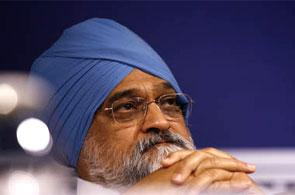 | « Back to article | Print this article |
Plan panel deputy chairman Montek Singh Ahluwalia on Wednesday expressed confidence that the current account deficit will come down to 2.5 per cent of GDP in the next two to three years from about 5 per cent currently.
"Traditionally we have seen it (current account deficit) at 2.5 per cent of the GDP at comfortable level. I think we will take at least two to three years to get there...I think this country for another 20 years can run CAD at around 2.5 per cent of GDP," he said.
 Ahluwalia was addressing a meeting of the Asia Pacific Regional Committee in New Delhi.
Ahluwalia was addressing a meeting of the Asia Pacific Regional Committee in New Delhi.
Prime Minister's Economic Advisory Council (PMEAC) has projected India's CAD at around 5 per cent of GDP for 2012-13.
It had reached to a historic high of 6.7 per cent of the GDP in the quarter ended December 2012.
He said while bringing in investments, it is also necessary to manage the high current account deficit.
"There is no known forecast of India's macro economy that does not involve the significant current account deficit. If we have the capacity to grow at 8 per cent, it is extremely unlikely that the industrialised countries will grow at 8 per cent," he said.
In this context, Ahluwalia said it is logical for the capital to be redirected towards India and other Asian countries.
However, the problem for India is that CAD is "too high," he said.
Talking about the falling economic growth, Ahluwalia said besides global slowdown, India is also facing many domestic problems and supply side constraints.
"While the global slowdown was an important factor for (falling) export, it wasn't the only reason why we slowed down...I think there are a lot of domestic problems. They are all connected with a supply side rigidity. In many ways, I think these rigidities are result of several years of rapid growth which always puts a lot of pressure on the system," he said.
Ahluwalia said the Planning Commission was looking for holistic solutions and there was a need for coordinated action among various ministries to spur growth.
"Our job really is to take a whole view and take holistic solutions to these problems because it's not possible for these problems to be simply resolved by individual ministry. They very often require coordinated action by different ministries.
“I have no doubt that we will be able to solve these problems much better than we have anticipated these problems (to be)," he said.
India's economic growth rate is estimated at 5 per cent in 2012-13, the lowest in a decade, on account of poor performance of manufacturing, agriculture and services sectors.